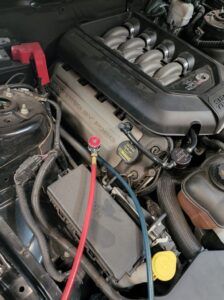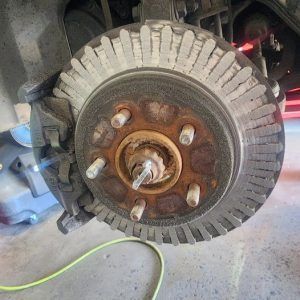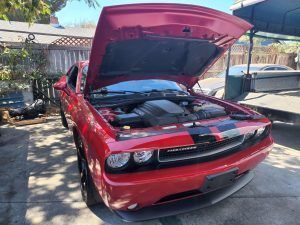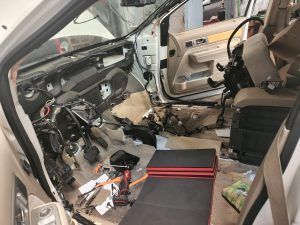Radiator Decoded: Understanding Your Car’s Cooling System
Are you curious about how your car’s cooling system works? Understanding the intricacies of your radiator system is crucial for maintaining optimal engine performance.
In this article, we will decode the radiator and delve into the inner workings of your car’s cooling system. The radiator plays a vital role in keeping your engine cool and preventing overheating. By dissipating heat from the engine coolant, it ensures that your car runs smoothly and efficiently.
But how does it actually work? We will break down the various components of a radiator system and explain how coolant circulates to regulate temperature.
Additionally, we will discuss common radiator issues that you may encounter and provide essential maintenance tips to keep your cooling system in top shape. By gaining a better understanding of your car’s radiator, you will be equipped with the knowledge to identify potential problems and take appropriate action.
So buckle up and get ready to decode the radiator!
Key Takeaways
– Regularly checking and maintaining the cooling system prevents costly repairs.
– Signs of a failing cooling system include overheating engine, coolant leaks, loss of engine power, and non-functional air conditioning.
– The radiator efficiently transfers heat from the coolant to the surrounding air.
– Regularly flushing the radiator and straightening bent fins maintain its efficiency.
The Importance of a Cooling System in Your Car
You can’t afford to ignore the importance of your car’s cooling system; it’s like having a lifeline that keeps your engine from overheating and breaking down on a scorching summer day. Proper cooling system maintenance is vital to ensure your engine runs smoothly and efficiently.
Regularly checking and maintaining your cooling system can prevent costly repairs and keep your car running at its best.
There are several signs of a failing cooling system that you should be aware of. One common sign is an overheating engine. If you notice your engine temperature gauge reading higher than normal or steam coming from under the hood, it’s time to address the issue.
Another sign is coolant leaks. If you see puddles of coolant under your car or notice a sweet smell, it could indicate a leak. Additionally, if you experience a loss of engine power or your air conditioning stops working, it could be a result of a failing cooling system.
Now that you understand the importance of a well-maintained cooling system, let’s delve into the role of the radiator in cooling your engine.
The Role of the Radiator in Cooling Your Engine
The engine’s temperature is regulated by a vital component responsible for dissipating heat: the radiator. The radiator plays a crucial role in cooling your engine and ensuring its efficiency. To understand the importance of the radiator, it’s essential to grasp the concept of radiator efficiency and the significance of proper radiator maintenance.
Radiator Efficiency:
– The radiator efficiently transfers heat from the engine coolant to the surrounding air, preventing the engine from overheating.
– The radiator’s core design maximizes the surface area for heat dissipation, ensuring optimal cooling performance.
Radiator Maintenance:
– Regularly flushing the radiator at recommended intervals removes debris and contaminants that can hinder its efficiency.
– Regularly inspecting the radiator fins and straightening any bent ones promotes uninterrupted airflow and cooling efficiency.
Maintaining the radiator’s efficiency is crucial for the overall health of your car’s cooling system. In the subsequent section about the components of a radiator system, we’ll delve deeper into the various elements that work in harmony to maintain the engine’s temperature.
Components of a Radiator System
In order to understand the components of a radiator system, you need to familiarize yourself with the radiator core and fins. These components are responsible for transferring heat from the coolant to the surrounding air.
Another important component is the radiator cap and pressure release. These functions help maintain the proper pressure within the system and prevent overheating.
Lastly, the cooling fan and thermostat work together to regulate the temperature of the coolant. They achieve this by either increasing or decreasing airflow through the radiator.
Please make sure to adjust the paragraph structure accordingly and use contractions.
Radiator Core and Fins
Get ready to dive into the world of radiator cores and fins, where you’ll discover the crucial components that keep your car’s cooling system running smoothly.
The radiator core is the heart of the radiator construction, consisting of a series of tubes and fins. These tubes carry the hot coolant from the engine, while the fins provide a large surface area to facilitate heat transfer. The core is typically made of aluminum or copper, as these materials have excellent thermal conductivity.
The fins are strategically placed to maximize radiator efficiency by dissipating heat into the surrounding air. Maintaining the cleanliness of the fins is vital, as any blockage can impede airflow and reduce cooling performance.
Now, let’s move on to the next section, where we’ll explore the importance of the radiator cap and pressure release.
Radiator Cap and Pressure Release
Let’s now explore the radiator cap and how it helps release pressure to keep your car running smoothly.
The radiator cap is an essential component of your car’s cooling system. Its main function is to seal the radiator and maintain the correct pressure inside the system. The cap also acts as a pressure relief mechanism, allowing excess pressure to escape.
When the pressure inside the radiator exceeds the predetermined limit, the cap opens, releasing the pressure and preventing any damage to the radiator or other cooling system components. This ensures that your engine stays cool and prevents overheating.
As we move onto the next section about the cooling fan and thermostat, it’s important to understand the role of the radiator cap in maintaining the proper functioning of the cooling system.
Cooling Fan and Thermostat
The cooling fan and thermostat work together to regulate the temperature of your engine, ensuring optimal performance and preventing any potential damage.
– The cooling fan, controlled by the engine’s computer, kicks in when the engine reaches a certain temperature, helping to dissipate heat quickly.
– The thermostat acts as a valve, opening and closing to control the flow of coolant between the engine and the radiator. It ensures that the engine reaches its operating temperature quickly and maintains it within a certain range.
– A radiator fan malfunction can lead to overheating, which can cause severe damage to the engine. If your fan isn’t working properly, it may need to be replaced.
Now that you understand how the cooling fan and thermostat work, let’s explore how coolant circulates in the radiator system.
How Coolant Circulates in the Radiator System
As the engine heats up, the coolant rushes through the radiator, cooling down and flowing back into the engine. This continuous circulation of coolant is crucial for maintaining the optimal temperature of your car’s engine.
The coolant flow in the radiator system is facilitated by the radiator itself, which plays a vital role in the cooling process. The radiator functions by transferring the heat from the hot coolant to the surrounding air. It consists of a series of narrow tubes, known as the radiator core, which are connected to thin fins. These fins increase the surface area available for heat transfer.
As the hot coolant enters the radiator, it passes through the tubes, and the fins help dissipate the heat. The air flowing over the fins, either from the movement of the vehicle or from the cooling fan, carries away the heat, cooling the coolant.
Once the coolant has been cooled down in the radiator, it flows back into the engine through the coolant return hose. This continuous circulation ensures that the engine temperature remains within the optimal range.
By understanding how coolant circulates in the radiator system, you can appreciate the importance of maintaining a properly functioning cooling system.
Now, let’s explore common radiator issues and maintenance tips to ensure your car’s cooling system operates smoothly.
Common Radiator Issues and Maintenance Tips
To ensure your vehicle runs smoothly, it’s important to be aware of common radiator issues and how to properly maintain it. The radiator is a vital component of your car’s cooling system, responsible for dissipating heat and preventing the engine from overheating. However, it can encounter problems that may compromise its efficiency.
Here are some common radiator issues and maintenance tips to keep in mind:
– Radiator leaks: One of the most common problems is a radiator leak. Leaks can occur due to corrosion, damage from road debris, or worn-out hoses and connections. Regularly inspect your radiator for any signs of leaks, such as puddles of coolant under your car or a drop in coolant levels. If you notice a leak, it’s crucial to address it promptly to prevent further damage.
– Overheating prevention: Overheating is a serious issue that can lead to engine damage. To prevent overheating, ensure that your radiator is filled with the correct amount and type of coolant. Additionally, regularly check the coolant level and top it up as needed. It’s also essential to inspect the radiator cap for any signs of wear and replace it if necessary. Finally, keep an eye on the temperature gauge while driving, and if it starts to rise abnormally, pull over and let the engine cool down before continuing.
By being proactive in identifying and addressing common radiator issues, as well as following proper maintenance practices, you can ensure that your car’s cooling system functions optimally and your engine stays cool, preventing costly repairs down the line.
Frequently Asked Questions
How often should I flush my radiator?
You should flush your radiator every 2-3 years to maintain its optimal performance. Regular radiator maintenance prevents clogs, removes contaminants, and improves cooling efficiency, ensuring your car’s engine stays cool and runs smoothly.
Can I use water instead of coolant in my radiator?
Yes, you can use water instead of coolant in your car’s radiator. However, there are pros and cons to consider. Water is cheaper, but coolant provides better heat transfer and corrosion protection.
What are the signs of a failing radiator?
If your radiator is failing, you may experience symptoms such as overheating, coolant leaks, and a sweet smell inside the car. Troubleshooting involves checking for these signs and inspecting the radiator for damage.
How do I know if my radiator fan is working properly?
To troubleshoot your radiator fan, start by turning on your car and letting it reach operating temperature. If the fan doesn’t turn on, check the fuse and relay. Regular radiator maintenance is important to prevent overheating.
Can a radiator leak be fixed without replacing the entire radiator?
To fix a radiator leak without replacing the entire radiator, you can use a radiator leak repair product. These products are designed to seal small leaks and prevent further damage. Follow the instructions carefully for proper application.
Conclusion
In conclusion, understanding your car’s cooling system is crucial for optimal engine performance. The radiator plays a vital role in this system by dissipating heat from the engine.
It consists of various components, including the radiator, fan, and thermostat, which work together to regulate the engine temperature. Proper circulation of coolant is essential for efficient cooling.
Regular maintenance is necessary to prevent common radiator issues such as leaks or clogs. By taking care of your radiator, you can ensure a well-functioning cooling system and prolong the lifespan of your vehicle.







